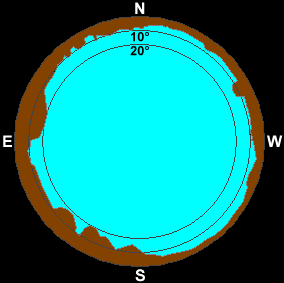| ||||||||||||||||||
| ||||||||||||||||||
NOTE: This page covers my old observatory, in operation from 1999 to 2007 and demolished in 2020. Please see this page for my current observatory.
This page contains information on the telescope and camera that I use, and has details on the observatory I recently completed building.
My ObservatoryPlease see this page for details on the observatory's construction. At right is a photo of how the building looked just after completion, with the roof rolled off as it would be at night. People have asked if the roof blocks the view to the north when it is rolled off, and the answer is yes, a little, but it doesn't matter since there is a house and a hill there. |

|
The observatory is a great thing to have because it saves hours of time in setting up equipment. For anyone out there considering building one, go ahead and do it! You won't regret it.

| Here in Ramona, California, I am privileged to live in a place where I can get a good view of the sky. The chart on the left shows how high the horizon is in various directions. This is so much better than anything I've had before, I can't describe it. Well, I'll try: at my last house, because of so many trees in the backyard and a streetlight out front, there was only one place I could put the telescope. I could only see about a 20 by 40 degree patch of sky at that location. That's why I wasn't posting many images in 1997... |
TelescopeI use an 8" F/10 Meade LX-200. It's the perfect telescope for CCD imaging. I bought it in June of 1995. In the summer of '96 I got an equatorial mount (wedge) for it. Before I had the wedge, the longest exposure I could manage without smeared images was about 15 seconds. Now I can take unguided exposures up to four minutes long with only minimal elongation of stars. (However, one-minute exposures are the longest that I can *consistently* get good.) All of my images are unguided.Here's what I had to say about the scope right after I bought it: |

|
|
FIRST LIGHT! June 29, 1995:
"I just got my brand spankin' new 8 inch Meade LX-200 telescope on Friday (today is Sunday) and last night I took it out and shot a bunch of pictures through it with my Cookbook 245 CCD camera. Most of the pictures were pretty lame, since this was my first night out with the camera and telescope! "There was quite a bit of drift and periodic error in the drive (about one arcminute's worth) but I think that is to be expected in an unguided alt-az system. I could only rarely take an exposure longer than 15 seconds without smearing. But the results are still very pleasing. "The LX-200 is a simply amazing telescope. Taking these images was incredibly easy. After focusing and aligning the telescope, all one needs to do to center the telescope on an object is push (for example), M, 8, 1, ENTER, GOTO, and there it is! Not always smack in the center of the frame, but always somewhere in the field of view. If you have the money, BUY THIS TELESCOPE!" |
|
It has worked without a glitch ever since, and I still love it! It has been worth every penny. A shameless plug: I bought my telescope at Oceanside Photo & Telescope. I really recommend this place for those of you living in Southern California. Take the I-5 to Mission, turn west (towards the ocean), it's about a block or two down on your right in a strip mall.
|
CameraAll of these images were taken with a Cookbook 245 CCD camera. This is a camera that can only be obtained by building it from plans. It is not complicated, but you do need some experience in electronics and metalworking. The more experience you have, the lower the final cost will be. All total, I think mine cost me about $650 and took a couple of months to complete.Together, my telescope and camera can see stars that are nearly one million times fainter than those you can see with the naked eye.
|  |
For those of you who are new to astronomy, a CCD camera can best be described as a cross between a video camera and a conventional film camera. A CCD camera uses a special sensor (the CCD, or charge-coupled device) to capture light and convert it to electrical charge. This is then converted to voltage, digitized, and sent to a computer for processing and display. Those new QuickCams for computers use the same principles as my camera, but are considerably less sensitive, noisier, and of lower quality.
Construction-wise, I did everything 'by the book', with a few exceptions. Most significantly, I didn't use a closed loop cooling system (I just had the two plastic cooling tubes running into a 1-gallon ice cream bucket). I have also added an LM35CZ to monitor the temperature, and have partially implemented a temperature regulator. Also, I have performed the LDC mod, which greatly increased performance.
The few conventional film photos I have on the site were taken with an old Canon 35mm SLR camera. There's not much interesting to be said about it.
Why don't you check out my Frequently Asked Questions page now?
Or, you can go back to my main astronomy page for lots more good images!
Comments? Questions? Click here to send email to me, Fred Bruenjes.
All text and images are © 1995-2001 Manfred Bruenjes - All Rights Reserved. Image inlining is strictly prohibited. Email for permission before using an image or text.